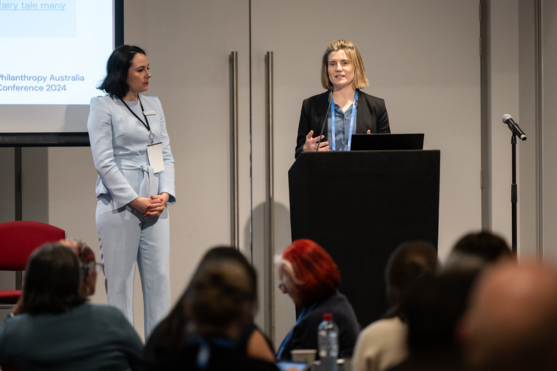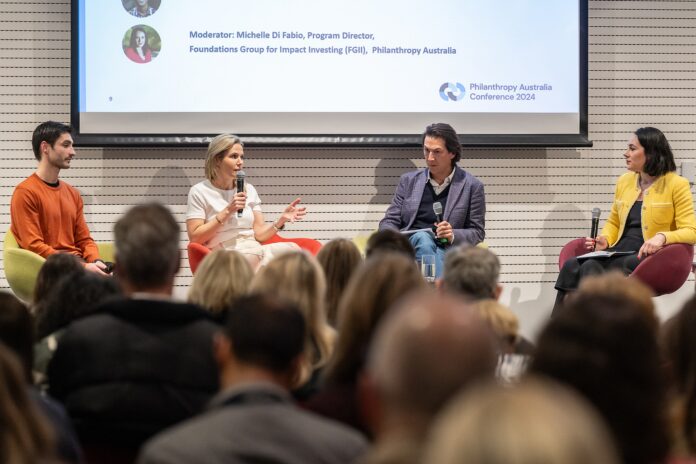‘Engagement and energy’ in impact investing is growing

Under the Shared Capital theme at the Philanthropy Australia conference on 5-7 August, a range of sessions exploring how the sector can look beyond philanthropic funding were presented and common themes emerged in relation to impact investment. Michelle Di Fabio, Philanthropy Australia’s Program Director, Foundations Group for Impact Investing, reflects on the key issues and discussions that developed, the resounding increase in interest – and what’s needed for continued growth.
The desire to learn more about impact investing is high. The questions that commonly arose during the conference sessions were: How do we get started and what are the barriers that can deter funders/investors from getting started or furthering their journey?
Ben Smith, of the Paul Ramsay Foundation, reflected on the sell-out sessions being “testament to the levels of genuine curiosity in the activity with strong engagement and energy felt throughout”. The greatest levels of interest appeared to be from those new to impact investing who are seeking to find out more before they dive in.
The journey starts with education
There was a breadth in understanding among attendees from beginner to advanced. Will Hart, from Evans & Partners, emphasised that “educational efforts are essential to enhance understanding and promote increased capital flows into the sector”. Defined by global peak body GIIN, Impact investments are investments made with the intention to generate positive, measurable social and environmental impact alongside a financial return. The need for a common impact investment language was also noted at the FGII peer-to-peer breakfast to ensure clarity for both impact specialists and the broader team.
Are challenges perceived or real?
A number of barriers to impact investing were raised. A poll in the session, “How foundations can be the catalyst for impact investing” indicated the equal top barrier to impact investing as “perceived or real sacrifice of financial returns” and “resources and skills” followed by “deal flow”.
While debate about the availability of risk-adjusted returns across the market is not new, the extent to which financial returns is a (perceived) barrier is inextricably linked to the foundation or charitable funder’s strategy and desire to achieve “impact” returns.
The concerns around resources and skills were considered in relation to the role of community supporting collaboration, knowledge sharing and education. The FGII breakfast also explored the notion of the “authorising environment” and the role of external experts on investment committees and outsourcing the resource gap, but also the role for internal champions to influence decision-making.
On the deal flow or supply side, Justin McCarthy, of Ord Minnett, spoke about the opportunity of Fixed Income Social Impact Bonds and the need for more size and scale. “In terms of ESG, ‘E’ and ‘G’ have been developed well in the financial markets. However, the ‘S’ has not progressed, due to issues around scale, very subjective measurability and difficulty in getting government (state and federal) support,” he said.
Setting the strategy: alignment across investment and philanthropic funding
Investments and philanthropic funding can co-exist in a funder’s portfolio. This was the focus of the masterclass in which Will Hart presented a portfolio approach to impact investing aligned to the organisation’s values. David Hetherington, of Impact Investing Australia, reflected on the range of practical tips and strategies for developing your impact portfolio at this session, “whether starting at the beginning or moving towards 100% impact”. He said it was important to recognise that each investor is on their own journey and there is no “one size fits all” approach, echoing the need for patience and persistence.
Hanna Ebeling, of Social Enterprise Finance Australia (Sefa), also explored the transitioning of grantees to investees, and establishing a successful partnership. “It is critical that both impact investors and social purpose organisations approach the journey with intentionality and shared objectives,” she said.
Simon Lewis, from GoodWolf, presented the case for impact capital in the session, “Leverage the balance sheet for purpose”. Simon explored the opportunity for charities to deploy assets to further the charitable objectives of the organisation, estimating that a third of charitable net assets in Australia (roughly $100 billion) are “investible assets” of charitable endowments and for-purpose organisations.

Collaboration and building community is key
Collaboration is a key enabler to building the market because impact at scale cannot be achieved alone. “How foundations can be the catalyst for impact investing” brought together the investee and investor lens with Phil Freeman, from Regen Labs, promoting the need to bring all actors across the ecosystem together, aligning partners, investors and investees along the journey.
The value of capability building was discussed to support not only social enterprises but the impact investing ecosystem, sharing impact readiness learnings for investors. It was argued that government also plays a fundamental role in bringing the ecosystem together to drive systems change at a federal and state level.
At the conference we celebrated the one-year anniversary of the market-building initiative, the Foundations Group for Impact Investing (FGII), with more than 50 members representing foundations and charitable funders. Ben Smith, FGII Chair, said the conference reinforced “the need for groups such as FGII to continue to break down barriers to understanding and encourage genuine collaboration”.
The conference highlighted the strong demand for impact investing in the philanthropic sector – and that foundations and philanthropic funders play a critical role in scaling the impact investing market. The sector can support the “how” by equipping both funders and for-purpose organisations with knowledge, skills and resources to achieve impact. The conference validated the role for market-building initiatives such as FGII to advance this conversation, build community and develop the broader impact investing ecosystem.
Image above: Michelle Di Fabio, left, with Hanna Ebeling at the ‘Practical approaches to getting the best results from impact investing’ masterclass.
If you would like to learn more about the Foundations Group for Impact Investing, attend the next FGII ‘Meet and greet’ session on 10 September.
The Foundations Group for Impact Investing (FGII) exists to improve the supply and demand for impact capital through convening foundations and charitable funders who are interested in starting, or enhancing their impact investing activities through origination, education and peer-to-peer learning. We welcome all members across the ecosystem to join the FGII community and expressions of interest from Foundations and Charitable funders for membership. Learn more about FGII here. Philanthropy Australia extends thanks to all presenters and individuals who supported the curation and delivery of the conference’s impact investing sessions.